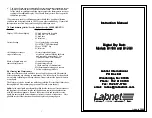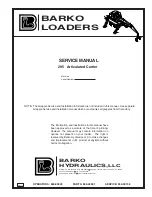
2
CRACKS IN THE BATTERY CASE.
6.
Check the water level in the battery. Fill the battery to the manufacturers specified level using the battery
manufacturer’s instructions.
7. Do not test a battery that is frozen.
BATTERY TESTER PLACEMENT
a)
Place battery tester as far away from battery as battery tester cables allow.
b)
Place battery tester in location for maximum air flow through battery tester.
BATTERY TESTING INSTRUCTIONS
1.
Be sure Voltmeter and Ammeter pointers are at zero. Meters not at zero can be adjusted to zero by adjusting the screw on face of meter until
meter pointer points to zero.
BATTERY TESTER CONNECTION PRECAUTIONS
1.
Before connecting battery tester to the battery, make sure the Load Control Knob is in the off position. To place the Load Control Knob in
the off position, turn the Load Control Knob counter clockwise as far a possible.
2.
Attach the clamps to the battery terminals. Make sure the battery tester clamp has a good connection to the battery terminal.
If steam comes out of Battery Tester:
Always store the battery tester in a cool dry location. If during testing steam comes out of the battery tester then
there is moisture in the carbon pile. Using a known good battery, connect the tester to the battery and turn the Load Control Knob clockwise until the
ammeter reads 100 amps for 10 seconds to remove the moisture, then turn the Load Control Knob counterclockwise to 0. This may have to be done
several times to remove all the moisture.
2
.
TO TEST THE STATE OF CHARGE OF BATTERY:
a.
Using “BATTERY TESTER CONNECTIONS PRECAUTIONS” above, connect the RED battery tester clamp to the POSITIVE (POS / + / P) battery post
terminal and the BLACK battery tester clamp to the NEGATIVE (NEG/ - / N) battery post terminal.
b.
Turn Load Control Knob clockwise to 100 amps for 5 seconds then turn Load Control Knob counter-clockwise until the ammeter reads zero. To
determine the state of charge of the battery read the Voltmeter.
1.
If the Voltmeter pointer is in green zone on the 'STATE OF CHARGE' scale, the battery can be load tested.
2.
If the voltmeter pointer is to the left of green zone on the 'STATE OF CHARGE' scale the battery voltage is too low for the battery to be tested. The
battery will have to be charged and then start at # 3 to determine the state of charge of the battery to determine if the battery can be load tested.
3.
If after charging, the battery tester voltmeter pointer does not read in the green zone after the test, the battery is defective.
3
.
BATTERY
LOAD TEST
Note: The battery tester creates heat during a load test. The battery tester may produce steam and odors. This is a normal occurrence.
a.
Using the DC AMP Meter as a reference, turn the Load Control Knob clockwise, slowly, to one half (1/2) of the batteries cold cranking amperage
(CCA) rating for 15 seconds. An alarm will sound when the 15 second test is complete. If the alarm does not sound after 15 seconds turn the Load
Control Knob to the off position by turning it counter clockwise.
b.
If the DC AMP Meter shows an increase or decrease in the amperage during the test, adjust the tester by turning the Load Control Knob to increase
or decrease the load on the battery to one half (1/2) of the batteries cold cranking amperage (CCA) rating. Do Not load the battery to more than one
half (1/2) of the batteries cold cranking amperage (CCA) rating.
c.
At the end of the 15 second test, read the voltage on the voltmeter and then immediately turn the battery tester off by turning the Load Control Knob
counter clockwise until the battery tester is off and shows 0 amps on the ammeter.
d.
Use the battery voltage reading taken at the end of the battery load test to determine if the battery is good or defe
ctive. Use the “Battery Load Test
Temperature Compensation Chart” on the side of the battery tester to determine if the battery is good or defective. For example: If the outside
temperature is 60 degrees Fahrenheit, a voltage reading above 9.6 volts would show the battery to be good and a voltage reading below 9.6 volts
would show the battery to be defective.
e.
If smoke is emitted from any cell of the battery, the battery is defective regardless of the test results.
Multiple Tests:
This battery tester creates a large amount of heat while testing a battery. Before using the battery tester to test another battery allow
enough time for the battery tester to cool down. This could be as long as 10 minutes. Not allowing the battery tester to coo l down between tests will
reduce the life expectancy of the battery tester and could damage it.
3
.
ALTERNATOR AND REGULATOR CHARGING TEST
a.
Make sure that the battery in the car tests good.
b.
Using “BATTERY TESTER CONNECTIONS PRECAUTIONS” above, connect the RED battery tester clamp to the POSITIVE (POS / + / P) battery
post terminal and the BLACK battery tester clamp to the NEGATIVE (NEG/ - / N) battery post terminal.
c.
With the vehicle running, the pointer on the Voltmeter should be in the green zone. If the pointer is in the red zone the alternator is not producing
adequate voltage to charge the battery.
d.
Check vehicle service manual for alternator and regulator specifications.
Summary of Contents for 45115
Page 4: ......






















